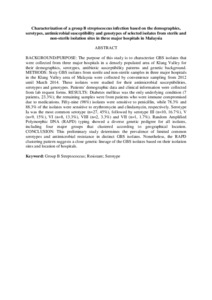Citation
Suhaimi, Mohd E. S. and Mohd Desa, Mohd Nasir and Eskandarian, Narges and Pillay, Stella G. and Ismail, Zalina and Neela, Vasantha Kumari and Masri, Siti Norbaya and Nordin, Syafinaz Amin
(2017)
Characterization of a group B streptococcus infection based on the demographics, serotypes, antimicrobial susceptibility and genotypes of selected isolates from sterile and non-sterile isolation sites in three major hospitals in Malaysia.
Journal of Infection and Public Health, 10 (1).
pp. 14-21.
ISSN 1876-0341; ESSN: 1876-035X
Abstract
BACKGROUND/PURPOSE: The purpose of this study is to characterize GBS isolates that were collected from three major hospitals in a densely populated area of Klang Valley for their demographics, serotypes, antibiotic susceptibility patterns and genetic background. METHODS: Sixty GBS isolates from sterile and non-sterile samples in three major hospitals in the Klang Valley area of Malaysia were collected by convenience sampling from 2012 until March 2014. These isolates were studied for their antimicrobial susceptibilities, serotypes and genotypes. Patients' demographic data and clinical information were collected from lab request forms. RESULTS: Diabetes mellitus was the only underlying condition (7 patients, 23.3%); the remaining samples were from patients who were immunocompromised due to medications. Fifty-nine (98%) isolates were sensitive to penicillin, while 78.3% and 88.3% of the isolates were sensitive to erythromycin and clindamycin, respectively. Serotype Ia was the most common serotype (n=27, 45%), followed by serotype III (n=10, 16.7%), V (n=9, 15%), VI (n=8, 13.3%), VIII (n=2, 3.3%) and VII (n=1, 1.7%). Random Amplified Polymorphic DNA (RAPD) typing showed a diverse genetic pedigree for all isolates, including four major groups that clustered according to geographical location.
CONCLUSION: This preliminary study determines the prevalence of limited common serotypes and antimicrobial resistance in distinct GBS isolates. Nonetheless, the RAPD clustering pattern suggests a close genetic lineage of the GBS isolates based on their isolation sites and location of hospitals.
Download File
![[img]](http://psasir.upm.edu.my/61089/1.hassmallThumbnailVersion/Characterization%20of%20a%20group%20B%20streptococcus%20infection%20based%20on%20the%20demographics%2C%20serotypes%2C%20antimicrobial%20susceptibility%20and%20genotypes%20of%20selected%20isolates%20from%20sterile%20and%20non-sterile%20isolation%20sites%20in%20three%20major%20hospitals.pdf)  Preview |
|
Text (Abstract)
Characterization of a group B streptococcus infection based on the demographics, serotypes, antimicrobial susceptibility and genotypes of selected isolates from sterile and non-sterile isolation sites in three major hospitals.pdf
Download (6kB)
| Preview
|
|
Additional Metadata
Actions (login required)
 |
View Item |

